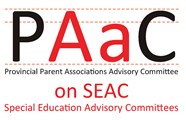Procedures may be different depending on Board by-laws; please refer to the rules for committee meetings at your specific board. Some SEACs make only a few Motions each year related to the Special Education Plan and/or the Special Education Budget. Other SEACs make Motions regularly either to make sure important information is shared with Trustees or to request specific information or resources to assist the work of SEAC. (See Appendix 4 for more information on making motions and an example template.) See Table 7 for a sample template for a SEAC Motion and Table 8 for a sample script for making motions.
Table 7: Sample Template for a SEAC Motion
|
XYZ District School Board |
|
| Be it Resolved that SEAC recommends to the Board of Trustees that……..
|
|
| Moved by: | SEAC Member’s Name |
| Seconded by: | SEAC Member’s Name |
| Date: | |
As an accountability mechanism, SEAC members need to know what happens to their motions and what the response was from the Trustees and board administration. This is especially true for the motions related to the Special Education Plan and the Special Education Budget, to which SEAC is required, by regulation, to provide input. These motions are often made in June at the end of the school year, and as SEAC does not meet again until September, SEAC members need to be informed about how the motions were received by the Trustees.
Effective Practices to track motions and the school board or Trustee response include:
- Trustee members have a role in sharing information between the board and SEAC.
- Tracking past motions through the Business Arising section of the agenda and identifying who will report on the motion, either verbally or in writing.
- Creating an action chart attached to each Agenda to track past motions and prepare for new motions.
- Providing SEAC members with a written response to motions from the Trustees and/or board administration staff.
Table 8: Sample Script for Motions at a Meeting
|
Who Speaks |
Action |
Script |
| SEAC Member 1 | Reading the Motion | “I would like to move the motion. Be it resolved that SEAC recommends to the Board of trustees that…” |
| Chair | Asking SEAC members | “Is there a seconder for this motion?” |
| SEAC Member 2: | Raising Hand | “I second the motion” |
| Note: Only after the motion has been made and seconded should the motion be discussed. | ||
| Chair | Addressing members | “Is there any discussion?” |
| Note: When discussing the motion, members should start their remarks with a statement on whether they are for or against the motion. | ||
| Chair | Members raise their hands, if they want to speak to the motion. | “I have a list of speakers. Please start, SEAC member 1.” |
| SEAC Member 1 | “I support the motion for the following reasons…..” | |
| Chair | “SEAC member 5” | |
| SEAC Member 5 | “I speak against the motion because….” | |
| Chair | “SEAC member 6 do you want to comment on the motion? | |
| SEAC member 6 | “I would like clarification about….” | |
| Chair | “It sounds like there is support to make a change to the motion. SEAC member 2” | |
| SEAC member 2 | Reading the amended motion | “I wish to make a friendly amendment to the motion to address these concerns, by adding the following words and changing the motion to read…” |
| Chair | “Is this change agreeable to the mover, SEAC Member 1?” | |
| SEAC Member 1 | “I agree to the change to the motion.” | |
| Chair | Addressing the Secretary | “Can we please hear the amended motion? |
| SEAC Secretary | Reads the amended motion | “Be it resolved that SEAC recommends to the Board of Trustees…….” |
| Chair | Looking at members. The Chair and Secretary count all the raised hands. | “Is there any further discussion? Seeing none, I will call for a vote on the motion. All those in favour, please raise your hands.” |
| Chair | The Chair and Secretary count all the raised hands. | “All those opposed to the motion, please raise your hands.” |
| Chair | The Chair and Secretary count all the raised hands. | “Are there any abstentions from the vote? Please raise your hands.” |
| When there are more members who support the motion than voted against the motion, the motion will be passed. | ||
| Chair | “The motion is carried.” | |
